Clayton’s conservation to be completed in time for 20th anniversary
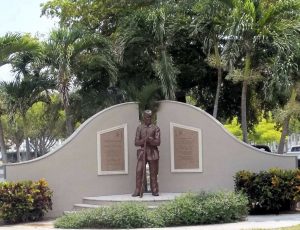 On a clear, crisp morning twenty years ago this Veteran’s Day, 10-year-old Kendra Myers screamed and ducked for cover as musket fire reverberated through Centennial Park before being swallowed by the still waters of the Caloosahatchee River. The reports issued from matchlocks shot by members of RHL DabneyAmerican Legion Post 192 who were attired that morning in the uniform of Union foot soldiers. No, it wasn’t part of a Civil War re-enactment. Post 192 was on hand
On a clear, crisp morning twenty years ago this Veteran’s Day, 10-year-old Kendra Myers screamed and ducked for cover as musket fire reverberated through Centennial Park before being swallowed by the still waters of the Caloosahatchee River. The reports issued from matchlocks shot by members of RHL DabneyAmerican Legion Post 192 who were attired that morning in the uniform of Union foot soldiers. No, it wasn’t part of a Civil War re-enactment. Post 192 was on hand 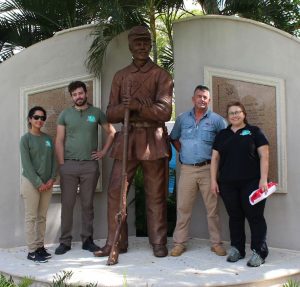 with U.S. Army General Johnny Edward Wilson, U.S. Rep. Alcee Hastings and State Senator Tom Rossin (D-West Palm Beach) to dedicate a monument to companies D & I of the 2nd Regiment of the United States Colored Troops that had been installed in Centennial Park by North Fort Myers sculptor Don J. Wilkins at the request of the Fort Myers Beautification Advisory Board.
with U.S. Army General Johnny Edward Wilson, U.S. Rep. Alcee Hastings and State Senator Tom Rossin (D-West Palm Beach) to dedicate a monument to companies D & I of the 2nd Regiment of the United States Colored Troops that had been installed in Centennial Park by North Fort Myers sculptor Don J. Wilkins at the request of the Fort Myers Beautification Advisory Board.
The monument consists of a heroic-size Union sergeant who 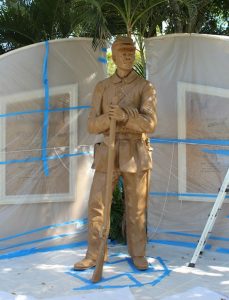 stands atop a landing in front of an opening between two gently curving concrete walls. The fictional African-American soldier in the monument represents the 168 men from companies D & I who were stationed in Fort Myers during the last 18 months of the Civil War. That contingent was responsible for repelling an attack on February 20, 1865 initiated by Major William Footman and 275 members of the Florida Special Cavalry, 1st Battalion, popularly known as the “Cow Cavalry.” Footman and the Cow Cavalry had orders to burn Fort Myers to the ground. Had they succeeded, it’s likely that the settlers who arrived a year later would have gone elsewhere to build their homes. So in a very real sense, the
stands atop a landing in front of an opening between two gently curving concrete walls. The fictional African-American soldier in the monument represents the 168 men from companies D & I who were stationed in Fort Myers during the last 18 months of the Civil War. That contingent was responsible for repelling an attack on February 20, 1865 initiated by Major William Footman and 275 members of the Florida Special Cavalry, 1st Battalion, popularly known as the “Cow Cavalry.” Footman and the Cow Cavalry had orders to burn Fort Myers to the ground. Had they succeeded, it’s likely that the settlers who arrived a year later would have gone elsewhere to build their homes. So in a very real sense, the 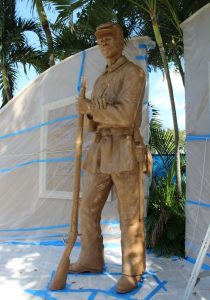 town of Fort Myers owes its existence to the men of companies D & I of the USCT 2d Regiment.
town of Fort Myers owes its existence to the men of companies D & I of the USCT 2d Regiment.
The monument has needed some repairs and maintenance since 2014. Some of the coping on one of the walls was knocked off by falling limbs during Hurricane Irma. By then, the City had already allocated funds to put the monument and several other public artworks in good repair, but because of the storm damage, the City Manager had to find additional funding in order to initiate the work.
The work finally started on October 1, with conservators from Miami-based Rosa Lowinger & Associates (RLA) starting on the USCT 2nd Regiment monument, The Florida Panthers 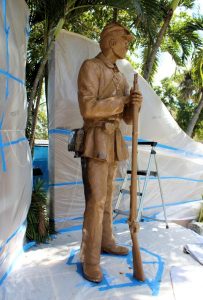 in the median on Monroe just outside the entrance to Centennial Park East, and The Great Turtle Chase as the base of the brick wall marking the entry.
in the median on Monroe just outside the entrance to Centennial Park East, and The Great Turtle Chase as the base of the brick wall marking the entry.
After cleaning all three pieces with conservation-grade detergent, the conservators began stripping off the paint, one layer at a time, to expose the underlying metallic resin composite that North Fort Myers sculptor Don “D.J.” Wilkins mixed to cast these sculptures. Next, they injected a special epoxy into cracks and fissures to stabilize the composite, bind the medium together and seal the inside from rainwater, humidity and corrosion-causing deposits of minerals and salt.
That part of the 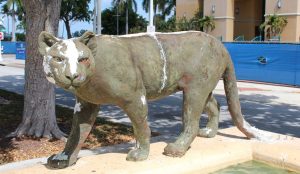 conservation was completed last week, culminating in the application of an undercoat of primer. In the case of The Florida Panthers, RLA had had to replace part of the male’s tale (broken off by projectiles during Hurricane Irma), repair the female’s tale and reconstruct the cub. The lower right leg and foot of the infant
conservation was completed last week, culminating in the application of an undercoat of primer. In the case of The Florida Panthers, RLA had had to replace part of the male’s tale (broken off by projectiles during Hurricane Irma), repair the female’s tale and reconstruct the cub. The lower right leg and foot of the infant 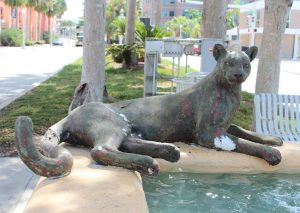 in The Great Turtle Chase had to be refabricated along with toes on the baby’s left foot.
in The Great Turtle Chase had to be refabricated along with toes on the baby’s left foot.
RLA is back in town this week. Yesterday, they sprayed the Civil War soldier (nicknamed Clayton) with a top coat of bronze-colored marine-grade metallic paint that is specially formulated to seal and protect the cast from heat, humidity, ultraviolet radiation and salt and mineral deposits. With that done, 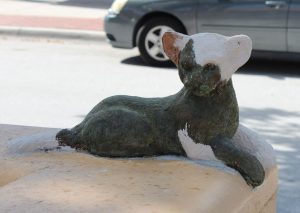 RLA will turn its attention next to The Florida Panthers, The Great Turtle Chase and the Buckingham & Paige Army Air Field Monument.
RLA will turn its attention next to The Florida Panthers, The Great Turtle Chase and the Buckingham & Paige Army Air Field Monument.
The conservators expect to begin work on another Fort Myers artistic landmark that finds itself in dire need of repair – the Wes Nott Memorial on the campus of Lee Memorial Hospital, with conservation of Uncommon 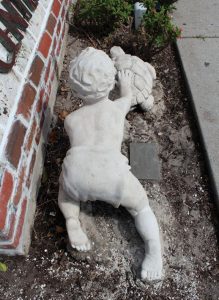 Friends slated for early January.
Friends slated for early January.
At the same time RLA is conserving these sculptures, local contractor Chris-Tel Construction is pressure washing, repairing and repainting the non-art components of each installation. Chris-Tel has already re-grouted the tile on the Travertine steps and landing on the USCT 2nd Regiment Monument and replaced the section of coping shorn off by Hurricane Irma. Now that RLA is done painting Clayton, the walls behind the soldier will be given a fresh coat of paint over the next few days, returning the installation to its original condition in time for the 20th anniversary of its dedication on November 11, 1998.
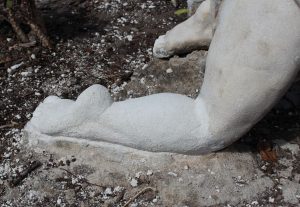 It’s fitting that Clayton is being returned to his original state in time for Veteran’s Day. The 8-foot-tall statue has the distinction of being the first Civil War statue in the South to pay tribute to African-American Union soldiers. And while Clayton does pay homage to all of the 179,000 black men (10% of the Union Army) who served as soldiers in the U.S. Army, with another 19,000 serving in the Navy,
It’s fitting that Clayton is being returned to his original state in time for Veteran’s Day. The 8-foot-tall statue has the distinction of being the first Civil War statue in the South to pay tribute to African-American Union soldiers. And while Clayton does pay homage to all of the 179,000 black men (10% of the Union Army) who served as soldiers in the U.S. Army, with another 19,000 serving in the Navy, 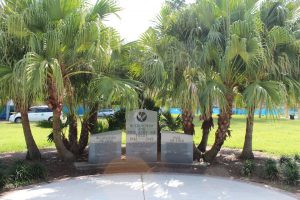 the contribution of the 168 black troops garrisoned in Fort Myers in 1865 is particularly meaningful.
the contribution of the 168 black troops garrisoned in Fort Myers in 1865 is particularly meaningful.
“[The fact that they saved the fort from total destruction] means a lot to people in Lee County’s black community, who have had to fight for their place in local history as well as for their place in contemporary society,” 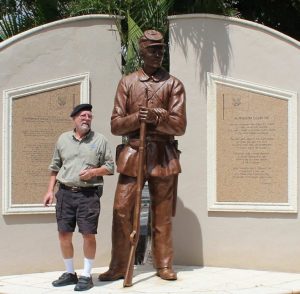 editorialized the News-Press on November 11, 1998. “The U.S. Colored Troops at Fort Myers … are the spiritual ancestors of living black veterans who are still fighting for their rights in our own time.”
editorialized the News-Press on November 11, 1998. “The U.S. Colored Troops at Fort Myers … are the spiritual ancestors of living black veterans who are still fighting for their rights in our own time.”
Interestingly, not only was slave labor used to build the old fort between 1852 and 1855, it was a force of 40 black railroad workers who saved the town from destruction by conflagration during the Great Fire of 1903.
October 23, 2018.














 Tom Hall is both an amateur artist and aspiring novelist who writes art quest thrillers. He is in the final stages of completing his debut novel titled "Art Detective," a story that fictionalizes the discovery of the fabled billion-dollar Impressionist collection of Parisian art dealer Josse Bernheim-Jeune, thought by many to have perished during World War II when the collection's hiding place, Castle de Rastignac in southern France, was destroyed by the Wehrmacht in reprisal for attacks made by members of the Resistance operating in the area. A former tax attorney, Tom holds a bachelor's degree as well as both a juris doctorate and masters of laws in taxation from the University of Florida. Tom lives in Estero, Florida with his fiancee, Connie, and their four cats.
Tom Hall is both an amateur artist and aspiring novelist who writes art quest thrillers. He is in the final stages of completing his debut novel titled "Art Detective," a story that fictionalizes the discovery of the fabled billion-dollar Impressionist collection of Parisian art dealer Josse Bernheim-Jeune, thought by many to have perished during World War II when the collection's hiding place, Castle de Rastignac in southern France, was destroyed by the Wehrmacht in reprisal for attacks made by members of the Resistance operating in the area. A former tax attorney, Tom holds a bachelor's degree as well as both a juris doctorate and masters of laws in taxation from the University of Florida. Tom lives in Estero, Florida with his fiancee, Connie, and their four cats.